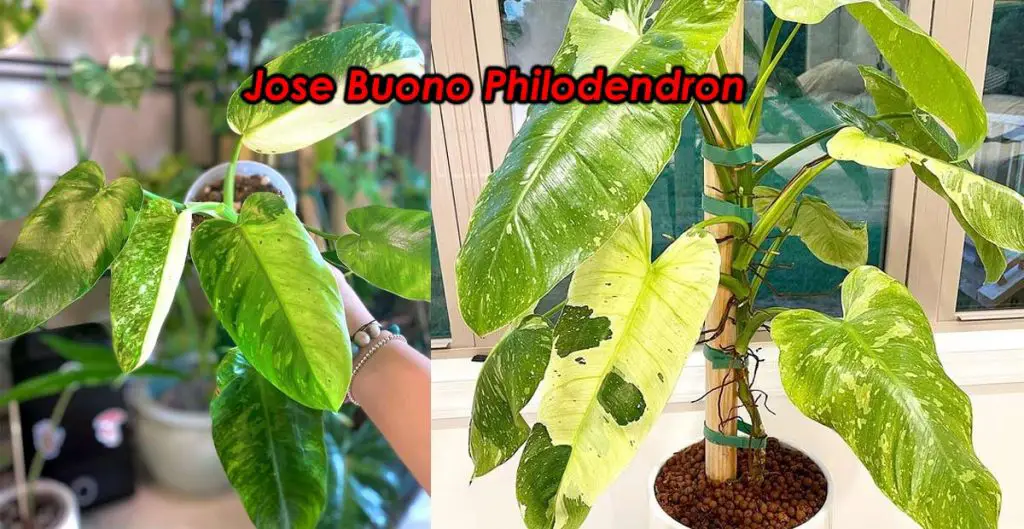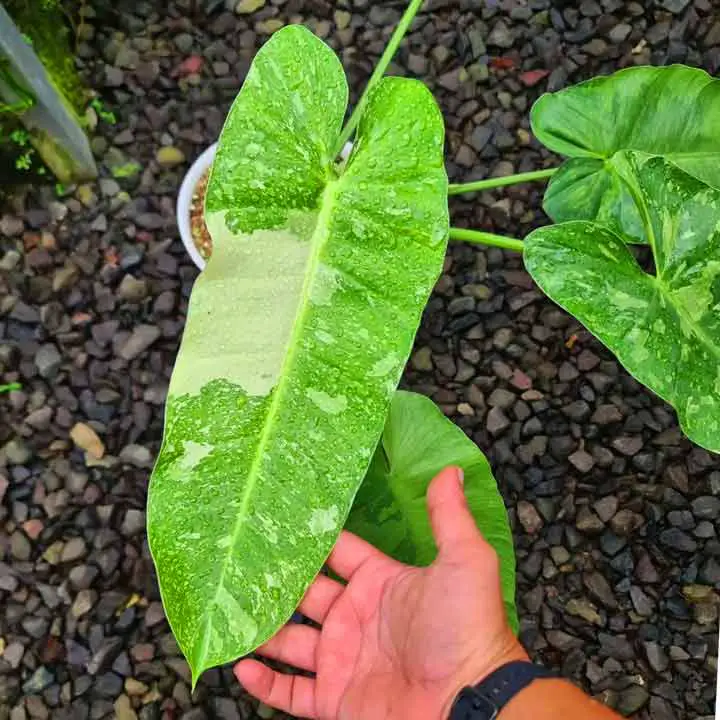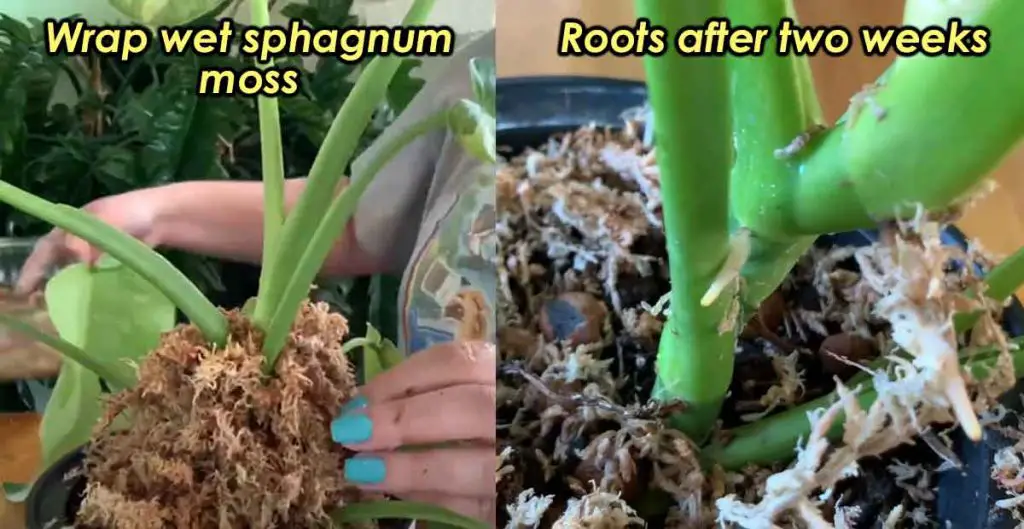Philodendron Jose Buono Care
Water once to twitch a week to care for Jose Buono philodendron. Keep direct sunlight low. Bright indirect light is best. Use rich organic soil with good drainage. Keep the temperatures between 60 and 85 degrees. Humidity is not super important, but try to keep it above 60% for best plant care.

At a glance – Run through
| Plant Type | Climbing Aroid Arum Araceae. Has stable variegated leaves. Probably a hybrid philodendron |
| Lighting | Bright indirect light is best. A few hours of morning sunlight is good. Mid-day sunlight might damage the plant |
| Temperature | 60-85 degrees is best for Jose Buono. Avoid getting temperatures under 50 degrees, this could cause permanent damage |
| Watering | Water once to twice a week. Check if the top two inches of soil are dry before watering |
| Humidity | Medium-high. 60%+ is best |
| Growth and Size | Can grow up to 4 feet tall and 4 feet wide |
| Difficulty Growing | Very easy to grow. Requires amounts of pruning and maintenance |
How hard is it to grow Philodendron Jose Buono?
This plant is easy to take care of. It is resistant to bugs and can handle a lot of temperatures. It thrives best in high humidity. Normal humidity will do just fine.
Jose Buono Background information
| Origin Country | The plant is named after Jose Buono Colon from Puerto Rico. Can be found in Columbia and the Caribbean |
| Botanical Scientific Name | Philodendron “Jose Buono” |
| Common Names | Philodendron Variegatum, Philodendron Domesticum, Philodendron Ilsmanii, Philodendron Imbe, Variegated Spade Leaf Philodendron and hastatum variegata |
| Price | Prices are between $70 and $110. It goes for $100 on Etsy |
Jose Buono Appearance
Philodendron Jose Buono grows like a shrub or a bush. Mature plants have a more distinguished look. They will climb and branch out. The stems are naturally very leggy.
Growth – How Big Will Jose Buono Plant Get? – Climber?
The Jose Buono can get very big under good conditions. Plants in high humidity can grow to over a meter tall (4 feet). Jose Buono is a climbing philodendron variant. Though it is not the best climber in the philodendron family. Higher humidity encourages the plant to grow aerial roots that can cling onto poles or trees.
Foliage – Flowering
The leaves come in a large range of varieties. Most will grow green with a few marbled spots. Mature variegated leaves will get a beautiful white and golden color. If you are lucky, one of the leaves will be completely marbled and variegated.
Mature leaves can grow huge. Sometimes up to 3 feet long. These leaves are a weight to behold when they are marbled.
This philodendron does not flower as often as many other variants. When the plant blooms, it makes a beautiful little flower. It grows a green 2-inch spathe that is white on the outside. Inside there is a nice petite white spadix.
Jose Buono Plant Care Guide
When it comes to proper plant care, the most important areas are lighting, temperature, watering, and humidity. We will look at all the most important areas to take proper care of your philodendron.
Optimal Lighting
Philodendron Jose Buono likes bright indirect light. Allow the plant to get a few hours of direct sunlight. Too much sunlight will burn and scorch the leaves. The variegated leaves are especially sensitive to excessive direct sunlight. Place the plant in and north or east-facing window to get the perfect amount of sunlight.
If you wanna place the plant in a south or west-facing window, keep the plant a few feet from the window. If you place it directly on the window sill, you risk scorching the plant’s leaves. This will ruin the plant’s looks and health.
2-4 hours of morning light is healthies for the plant. If Jose Buono gets too little sunlight, you risk the stems getting leggy. You can identify leggy stems if they are way longer than you would expect. Placing it in a north or east-facing window is the best way to avoid the plant getting leggy.
If you place the plant outdoor, try to avoid placing it in direct sunlight. The plant comes from riverbanks along with the South American rainforests. It rarely gets direct sunlight in the rainforest. Remember the variegated leaves are sensitive.
Water Requirements For Jose Buono Philodendron
Water the Jose Buono about two times a week during summer and spring. Try to keep the soil moist in the warmer months. In winter you will need to scale back on watering. In closer months, less water is evaporated. The heat and sunlight cause faster water depletion. Water is used faster during growing periods with plenty of sunlight.
The best way to find the sweet spot is to check manually. Put your finger into the soil to check if it is dry. Let the top 2 inches of soil dry out before watering again.
To care for Philodendron Jose Buono avoid overwatering. The roots of Jose Buono are susceptible to overwatering. Too much water will cause root rot. This root disease comes from watering too often or letting the plant sit in water.
To avoid root rot, water the plant throughout. Let excess water flow out of the pot. If your plant sits on a plate, remember to remove the water and clean the plate. Root rot is a disease from watering too often, and not from watering too much when the soil is dry.
Letting the soil get too dry is also detrimental to the plant’s health. Try to keep the bottom of the soil moist at all times. Not muddy moist, but normal moist.
Potting Soil / Substrate
The soil should be rich with organic content for the Jose Buono. This plant needs soil with good drainage and aeration. Buy a soil that has good water retention and good drainage. This is the best way to keep the soil moist, whilst avoiding root rot.
Your organic content should be coco coir or sphagnum peat moss. The soil should be supplemented with perlite or vermiculite. Avoid some regular potting soil, as they might cause the soil to become too muddy after watering.
Sandy soil is a no-go with the Jose Buono. The roots cannot effectively thrive in sandy or muddy soils.
The ideal soil pH is around 5-7. Slightly acidic to neutral soil conditions are best for the roots and plant health.
Make a soil consisting of a light organic substrate with perlite to increase drainage and water retention.
For the perfect recipe for Jose Buono philodendron, use this:
- 30% orchid bark
- 30% coco coir/sphagnum peat moss
- 25% perlite or vermiculite
- 15% worm castings
With a good amount of worm castings, you will not need to supplement with fertilizers. As long as you repot with worm castings every year, you will have a natural organic fertilizer for the roots.
To read more on philodendron soil recipes, go to teakandterracotta’s recipe guide.
Best Temperature
The best temperature for philodendron Jose Buono is between 60 and 85 degrees Fahrenheit. Avoid giving the plant too much heat, as water will evaporate too fast. At high temperatures, enzymatic activity is slowed causing the plant to grow slower.
Jose Buono does not tolerate freezing temperatures. So you should not place the plant outside during winter if you live in a tempered climate. The Jose Buono is perfect for a year-round indoor gardener.
Temperatures should not swing too much each day. Swinging temperatures will cause the leaves to slow growth. It is completely fine to keep the plant indoors all year long. The plant can experience permanent damage if it is kept at low temperatures. To avoid getting under 50 degrees Fahrenheit all year long.

Optimal Humidity
Humidity is not a huge issue for Jose Buono. The plant can survive low humidity, but it will cause the leaves to grow smaller.
Keep humidity between 60% and 80%. Higher humidity causes the plant to grow more full and vibrant. High humidity prevents a lot of diseases and pest issues.
We recommend laundry rooms, bathrooms, and kitchens for Jose Buono. These areas have higher humidities. If you live in dry areas you should buy a humidifier or mist the plant.
To artificially increase humidity, either try misting or place a water dish close by. Simply spray the leaves with water a few times a week to keep the leaves moist. Misting will also prevent the leaves pores from getting clogged with dirt and dust. A humidifier will keep the plant at perfect humidity even in dry climates. If the leaves stay wet at all times, there might come fungal issues.
Most of the time humidity will not be an issue at all for the Jose Buono. It is quite resilient to different conditions, making it a perfect houseplant for anyone.
Fertilizer for Jose Buono
Fertilizing depends on which soil you use. If you repot the plant every year with rich organic content you won’t need to fertilize it. Soil with worm castings is perfect for natural fertilization.
If you do not repot often, you should still fertilize. Use a regular liquid fertilizer once a month during summer and spring. Remember to dilute the fertilizer, and apply it after watering.
In fall and spring would not need to fertilize as often. Use once every 3 months during the colder months.
Pruning and Maintenance
Pruning and maintaining philodendron Jone Buono is very easy. You will rarely need to remove a large number of leaves.
As the plant grows big and strong, older leaves will naturally start to wilt. If you notice, you should prune them. Use a sterilized pruner to cut the dying leaves from the plant. This will allow the plant to focus its energy on more productive leaves.
You should clean the leaves at least twice a month. Mist the leaves and clean them with a cloth. This will remove dust and dirt clogging the leaves’ pores. Cleaning this way will also remove any pest infestations.
Jose Buono requires minimal effort to maintain. It is a great philodendron for beginners or pro-house plant gardeners. Indoor gardening is very easy with philodendron houseplants.
Jose Buono Propagation
There are many ways to propagate philodendrons. There are three main ways. Air-layering, soil propagation, and water propagation. Air-layering is the best and safest method of propagating a philodendron. The issue is that air propagation works best for fast climbing philodendrons. Jose Buono is not a good climber.
The best way to propagate Jose Buono is by using a mix of air-layering and water propagation. So, here are the steps to propagate the Jose Buono.
- Wrap wet sphagnum moss around the base of the plant.
- Use plastic wrap, and seal it with tape. Make sure the moss is wet.
- Wait 2 weeks, and keep the moss moist. Check for condensation on the plastic wrap.
- There should now be aerial roots in the sphagnum moss.
- Use a sanitized cutter to remove a stem with good aerial roots.
- Place the stem cutting in water for up to 10 days. Replace the water every 2 days.
- Once the root is 2 inches, you can place it into soil.
- Keep the plant moist and warm for a week.
- You should now have a healthy plant.

With this method, you should have a very very high chance of successful propagation.
It is best to propagate Jose Buono in the warmer months. New plants need warmth for the highest chance of success.
Pests and Diseases
All philodendrons can get insect infestations. Thankfully Jose Buono will rarely get any pest problems if you follow our pruning and maintenance section. As long as you wipe the plant with a damp cloth every now and then, you will be fine. If you still get problems, here is how to fix them.
The most common pests for philodendron are mealy bugs, aphids, and spider mites. Check the top and underside of the leaves once a week. Most bugs like dry humidity.
To take care of these infestations, spray water with isopropyl alcohol once a week on the affected spot. You should also rub neem oil on the leaves.
Where to buy it?
Jose Buono is very expensive right now. You can usually get philodendrons for $30-60 on Etsy. Unfortunately, Jose Buono is about $100 across the marketplace.
The best bet is to buy the plant from Etsy. Hopefully, the prices will fall sometime in the future. You can find it for $70 on the Facebook marketplace. If you are lucky, someone in a plant group on Facebook might give theirs away for free.
Philodendron Jose Buono Vs Imbe variegata
These plants are hard to differentiate. The Jose Buono is often sold as the Imbe variegated because of their similar looks. There are two main differences. The Imbe variegate has whiter spots than the Jose Buono. The leaves of the Imbe are sharper towards the end compared to Jose Buono.
Philodendron Jose Buono Vs Paraiso Verde
The Paraiso Verde has irregular leaves. The edge of all the philodendron leaves is wavy. Comparatively, the Jose Buono has smooth edges to its leaves.
Is the Jose Buono plant toxic?
Like most philodendrons, the Jose Buono is not healthy to consume. The mouth and tongue will swell, and then will its. Consuming the leaves might also cause nausea and stool issues. Keep the plant out of range from babies or curious dogs. Place the plant on a window sill.

